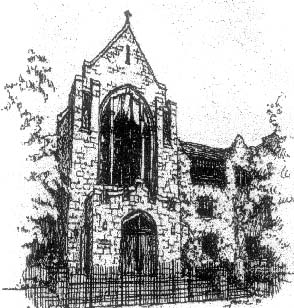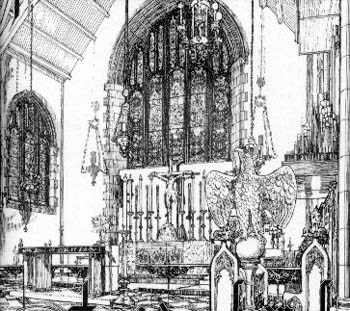 |
|

The church: Church of the Atonement, Chicago.
Denomination: Episcopal Church in the USA.
The building: A rather lovely rendition of English Gothic.
The neighbourhood: The church sits in a densly populated residential neighborhood that is one of the most diverse in the city. The surrounding streets are lined with apartment buildings and flats, mostly dating from 1880-1915. The lake front and a large stretch of sandy beach is just a few short blocks away, as is Loyola University, a large Roman Catholic institution. Many university students and other young people live in the area. The local population includes almost every ethnic group and nationality imaginable.
The cast: Rev Sheldon Foote preached. Another priest presided at the liturgy, but I couldn't find his name anywhere.
High Mass, the 16th Sunday after Pentecost.
How full was the building?
About one-third full, with people scattered singly, in pairs, or in small groups throughout the nave.
Did anyone welcome you personally?
No, but I arrived quite early, before the ushers/greeters took their stations.
Was your pew comfortable?
Comfortable enough for a wooden pew.
How would you describe the pre-service atmosphere?
Mostly quiet and reverential, with a few parishioners exchanging greetings and gossip.
What were the exact opening words of the service?
"Welcome to our candlelight service." A fuse had blown leaving only dim, mostly decorative, lighting. The lights were restored half way through the service, though I rather liked the mood produced by natural light coming through the stained glass windows, augmented by electric chandeliers.
What books did the congregation use during the service?
A service folder, "The Hymnal 1982", and "The Order of Mass", a booklet produced by the parish, incorporating the Rite II Eucharist from the American Prayer Book.
What musical instruments were played?
Organ. John Easterlind, an operatic tenor, provided music at the offertory and during communion.
Did anything distract you?
The service was musically rather odd. The organist could not settle on a tempo and had a penchant for using the trumpets at the strangest times, such as in the middle of a hymn stanza. The choir had not yet returned from summer break, and the congregation itself was apparently not used to singing the ordinary of the liturgy. In the midst of this musical desert, the operatic tenor effusively sang two very romantic (if not schmaltzy) pieces, including "The Holy City." The organ postlude sounded like someone strangling cats.
Was the worship stiff-upper-lip, happy clappy, or what?
The liturgy was Anglo-Catholic and formal, though I wouldn't exactly call it stiff upper lip. The service proceeded reverently, naturally, and with a minimum of fuss.

Exactly how long was the sermon?
10 minutes.
On a scale of 1-10, how good was the preacher?
5 – the sermon (based on the Gospel for the day, Matthew 18:21-35) was inoffensive, but unchallenging.
In a nutshell, what was the sermon
about?
It is sometimes hard to forgive.
Which part of the service was like being in
heaven?
The building is lovely, perhaps one of the lovliest in Chicago. There was much greeting among the parishioners and one could sense that people were glad to see each other after a week apart. There was a sense of community that is often visually absent in churches. The people were very welcoming.
And which part was like being in... er... the other place?
I love to sing hymns and enjoy sacred music very much. Trying to sing to the organist's playing was like... well, you know. The postlude was positively like descending into the bowels of the Other Place.
What happened when you hung around after the service looking lost?
As I was returning my hymnal to the back of the church, a young man greeted me and asked me if I was new. Then he was very insistent (very insistent – obviously that was his Sunday morning task) that I sign the guest book. When I asked about coffee, he introduced me to a parishioner, who then introduced me to others in his group. I was warmly greeted all around, as I was by others once I entered the parish hall.
How would you describe the after-service
coffee?
There was no coffee on account of the blown fuse. Iced tea and fruit punch were offered instead, along with a piece of cake. One of the priests was visibly agitated by there being no coffee!
How would you feel about making this church your regular (where 10 = ecstatic, 0 = terminal)?
5. This church is withing walking distance of my home, so I might consider it if I wasn't already quite involved in another parish.
Did the service make you feel glad to be a
Christian?
Yes.
What one thing will you remember about all this in seven days' time?
I really felt that the regular, active, worshipping community keeps this parish alive by their work and their faith.
| The Mystery Worshipper is sponsored by surefish.co.uk, the internet service provider from Christian Aid. By offering email services, special offers with companies such as amazon.co.uk and smile.co.uk, surefish raises more than £300,000 a year for Christian Aid's work around the world. Click here to find out how to become a Mystery Worshipper. And click here if you would like to reproduce this report in your church magazine or website. Top | Other Reports | Become a Mystery Worshipper! © Ship of Fools 1999 |